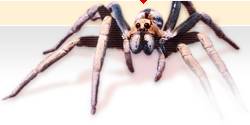
Mites
Order Sarcoptiformes
(by Bruce Halliday)
The order Sarcoptiformes includes over 130 families of soil mites in the suborder Oribatida, commonly known as oribatids. These are mostly slow-moving, heavily sclerotised mites that are most abundant and diverse in the upper layers of the soil and the associated organic litter. They feed on dead plant material and the associated microfungi, and most have very robust heavily sclerotised chelicerae, adapted for crushing fungal mycelium. Their role in feeding on decaying plant material means that they are very important in maintaining and enhancing soil fertility, and they have been the subject of a substantial ecological literature for that reason. A few species are beneficial in more direct ways, contributing to the control of pest mites, nematodes, and weeds. Others are themselves pests that damage crop plants (Colloff and Halliday 1998). Some act as intermediate vectors of tapeworm parasites of livestock (Denegri 1993). The Australian fauna was catalogued by Colloff and Halliday (1998), who listed 340 described species.
The order Sarcoptiformes also includes the cohort Astigmata, which until recently has been given equal rank with the Oribatida. The Astigmata includes the common flour mites and cheese mites that infest stored food and which damage stored grain on an industrial scale, the house dust mites that cause allergy and asthma in humans, and a wide range of fungivorous and saprophytic species in soil. Many of these species have a specialised immature form known as the hypopus, which attaches itself to insects for dispersal. The Astigmata also includes hundreds of species of feather mites that occur on birds, but the Australian fauna of these groups has never been studied in any depth. Domrow (1992) catalogued 204 species of Astigmata in 24 families that parasitise Australian vertebrates or occur on their bodies. These include the mites that cause such diseases as scabies (Sarcoptes scabiei), scaly leg of chickens (Knemidokoptes mutans) and several types of mange in domestic animals (e. g. the ear mite of dogs and cats, Otodectes cynotis).
References
Colloff M.J. & Halliday R.B. 1998. Oribatid Mites. A Catalogue of the Australian Genera and Species. CSIRO Publishing, Melbourne, 223 pp.
Denegri G.M. 1993. Review of oribatid mites as intermediate hosts of tapeworms of the Anoplocephalidae. Experimental and Applied Acarology 17, 567-580.
Domrow R. 1992. Acari Astigmata (excluding feather mites) parasitic on Australian vertebrates: an annotated checklist, keys and bibliography. Invertebrate Taxonomy 6, 1459-1606.

